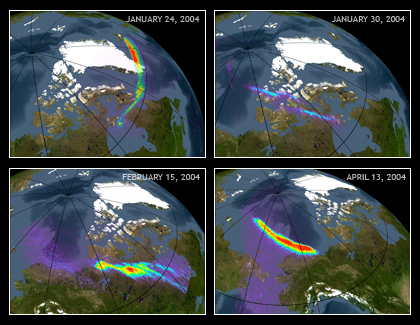December 28, 2005
CXC RELEASE: 05-10
In an unusual observation, a team of scientists has scanned the northern polar region of Earth with NASA's Chandra X-ray Observatory. The results show that the aurora borealis, or "northern lights," also dance in X-ray light, creating changing bright arcs of X-ray energy above the Earth's surface.
While other satellite observations had previously detected high-energy X-rays from the Earth auroras, the latest Chandra observations reveal low-energy X-rays generated during auroral activity for the first time.
The researchers, led by Dr. Ron Elsner of NASA's Marshall Space Flight Center in Huntsville, Ala., used Chandra to observe the Earth 10 times over a four-month period in 2004. The images were created from approximately 20-minute scans during which Chandra was aimed at a fixed point in the sky and the Earth's motion carried the auroral regions through Chandra's field of view.
From the ground, the aurora are well known to change dramatically over time and this is the case in X-ray light as well. The X-rays in this sample of the Chandra observations, which have been superimposed on a simulated image of the Earth, are seen here at four different epochs.
Auroras are produced by solar storms that eject clouds of energetic charged particles. These particles are deflected when they encounter the Earth's magnetic field, but in the process large electric voltages are created. Electrons trapped in the Earth's magnetic field are accelerated by these voltages and spiral along the magnetic field into the polar regions. There they collide with atoms high in the atmosphere and emit X-rays. Chandra has also observed dramatic auroral activity on Jupiter.
Dr. Anil Bhardwaj of Vikram Sarabhai Space Center in Trivandrum, India, is the lead author on a paper describing these results in the Journal of Atmospheric and Solar-Terrestrial Physics. Dr. Bhardwaj was a co-investigator on this project and worked with Dr. Elsner at NASA's Marshall Space Flight Center while this research was conducted.
The research team also includes Randy Gladstone (Southwest Research Institute, San Antonio, Texas); Nikolai Østgaard (University of Bergen, Norway); Hunter Waite and Tariq Majeed (University of Michigan, Ann Arbor); Thomas Cravens (University of Kansas, Lawrence); Shen-Wu Chang (University of Alabama, Huntsville); and, Albert E. Metzger (Jet Propulsion Laboratory, Pasadena, Calif).
NASA's Marshall Space Flight Center, Huntsville, Ala., manages the Chandra program for the agency's Science Mission Directorate. The Smithsonian Astrophysical Observatory controls science and flight operations from the Chandra X-ray Center in Cambridge, Mass.
Additional information and images are available at:
For information about NASA and agency programs on the Web, visit:
MEDIA CONTACTS
Steve Roy
Marshall Space Flight Center, Huntsville, Ala.
(256) 544-6535
Megan Watzke
Chandra X-ray Center, Cambridge, Mass.
(617) 496-7998




